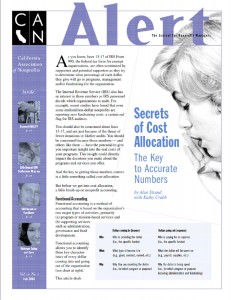 A few years back I co-wrote an article about getting accurate numbers from your financial system for the California Association of Nonprofits that was based on a workshop I developed. This blog post and the last post excerpt some of the material from that piece. For folks who would like the whole article you can click the above link. The other post is on cost allocation, this one is on setting up a functional accounting system.
A few years back I co-wrote an article about getting accurate numbers from your financial system for the California Association of Nonprofits that was based on a workshop I developed. This blog post and the last post excerpt some of the material from that piece. For folks who would like the whole article you can click the above link. The other post is on cost allocation, this one is on setting up a functional accounting system.
Functional accounting is a method of accounting that is based on the organization’s major types of activities, primarily (a) program or mission-based services and (b) supporting services such as administration, governance and fund development.
Functional accounting allows you to identify three key characteristics of every dollar coming into and going out of the organization:
| |
Dollars coming in (income) |
Dollars going out (expense) |
| Who |
Who is providing the dollar (i.e., the specific funder) |
Who is paying for an expense (i.e., the specific funder) |
| What |
What type of income it is (e.g., grant, contract, earned, etc.) |
What the dollar will be spent on (e.g., payroll, supplies, etc.) |
| Why |
Why they are providing the dollar (i.e., for which program or purpose) |
Why the dollar is being spent (i.e., for which program or purpose) Administrative and Fundraising would be a Why as well. |
Breaking down expenses by what and why reflects the broad outlines of major nonprofit reporting requirements. For example, the IRS Form 990 asks nonprofits to divide expenses by program, management/general and fundraising. A statement of functional expenses is required as part of the audit for voluntary health and welfare organizations.
But a statement of functional expenses is also recommended for every organization for three reasons. First, unless your organization is very small (less than $25,000 in revenue annually), you probably have to file a 990 or 990-EZ already. Second, even if you are very small now, you might someday be large enough to need an audit – so you might as well get in the habit of creating a statement of functional expenses right now.
Third, and perhaps more importantly, a statement of functional expenses is an ideal method for tracking the real costs of program and supporting activities, making it an invaluable tool for decision-making. It allows you to see exactly what Program X is costing, what Program Y is costing, whether your fundraising is proportionate to the areas that need it, whether you want to build, maintain or scale back a program and so forth.
The information found in a statement of functional expenses can most easily be organized, streamlined and accessed through the meeting of two basic functional accounting tools: your chart of accounts and your functional areas.
Chart of Accounts
A chart of accounts consists of numbered account names that describe the types of income and expenses that your organization experiences over time. It is the list of categories that tracks the what of each dollar coming into and going out of your organization.
Your chart of accounts should be flexible enough to change as your organization changes. For example, you want to be able to insert new income and expense categories as they arise. But you want to be able to insert them within the broader categories of the existing chart instead of simply appending them to the end of it, which is why it is numbered by the tens, hundreds and thousands instead of 1, 2, 3 and so on.
Functional Areas
Functional areas place the who and the what of each dollar into the why – the program or service for which that dollar is designated. Many organizations that I have worked with tend to track the why by funder or contract rather than by mission-based purpose. But if you use Functional Accounting, you can use functional areas to cross-cut funder information with programs/services and income or expense line items so you can accurately track any given dollar in its journey through your organization. If you haven’t already developed functional areas, start with your mission. Read your goals and values statements, and take a look at how your nonprofit is divided programmatically. Identify each larger purpose, within the overall organization, on which you spend time and money.
Each transaction coming into or going out of the organization should be identified with a code corresponding to the who, the what and the why of that transaction. The more you can integrate these three pieces, the higher-quality, more accurate reports you will produce. And you will produce them more quickly. If your accounting system cannot slice and dice your numbers these three ways, you might consider an upgrade of your financial software. Don’t forget also to integrate those three questions – who, what and why – into all your relevant processes such as payment requisition forms and record-keeping for bills that come in. It can take some time to set up, but once it is set up, tracking and reporting runs very smoothly. And it will make your auditor happy, too.
If you would like to learn about creating a functional accounting system and policies for your nonprofit please click on the image below.

 The filing thresholds for your 2010 form 990 have changed. Many organizations who were able to file the 990EZ for the past few years may no longer be able to now that the threshold for filing the full form 990 has dropped to $200,000 in gross receipts. But groups with less than $50,000 in gross receipts can now file the 990N postcard, up from $25,000 in 2009.
The filing thresholds for your 2010 form 990 have changed. Many organizations who were able to file the 990EZ for the past few years may no longer be able to now that the threshold for filing the full form 990 has dropped to $200,000 in gross receipts. But groups with less than $50,000 in gross receipts can now file the 990N postcard, up from $25,000 in 2009.
 A few years back I co-wrote an article about getting accurate numbers from your financial system for the
A few years back I co-wrote an article about getting accurate numbers from your financial system for the 